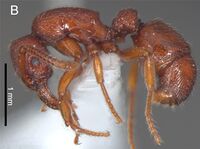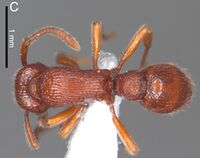Alfaria piei
| Alfaria piei | |
|---|---|

| |
| Scientific classification | |
| Kingdom: | Animalia |
| Phylum: | Arthropoda |
| Class: | Insecta |
| Order: | Hymenoptera |
| Family: | Formicidae |
| Subfamily: | Ectatomminae |
| Tribe: | Ectatommini |
| Genus: | Alfaria |
| Species: | A. piei |
| Binomial name | |
| Alfaria piei (Dias & Lattke, 2019) | |
The only known specimen of this species was collected in an area of Atlantic Forest in Itatiaia National Park, located in the Mantiqueira mountains, Rio de Janeiro, Brazil. The collection area is within the Alto-Montana forest formation, with trees smaller than those of lower altitudes and the soil is humid with large volumes of accumulated organic matter. The ant was taken from a leaf litter sample processed with a Winkler extractor. The Type-locality altitude is at the upper limit for minuta-group species. It remains to be seen if this ant is a specialist restricted to upper altitude, cooler forests or if it also inhabits lower altitude forests.
Identification
Dias & Lattke (2019) - A member of the minuta group. Mesosomal dorsum mostly longitudinally costulate; anterior margin of clypeus with weak median lobe, clypeal lamella absent; metanotal groove absent; propodeum armed with small,distinct tooth; foretarsal base with seta opposite protibial spur; dorsum of petiole with concentric rugulae; meso- and metatibiae with one apical spur each.
Alfaria piei can be easily identified as a member of the minuta-group because it presents the petiolar spiracle within a ventral cavity, the antennal insertions completely covered by the frontal lobes, a curved longitudinal carina in the malar area, and a row of setae on the protarsal base opposite the spur. However, the new species differs from other minuta- group members by having a prominent seta on the protarsal base opposite the spur (Lattke,1992). Another minuta-group character, the dorsomedian cephalic carina, is indistinct in this species on account of the costulate frons. Alfaria simulans, Alfaria fieldi, and Alfaria falcifera differ from Alfaria piei by not having their body covered with longitudinal costulae. In addition, Alfaria fieldi and Alfaria falcifera have falcate mandibles. Alfaria also may be easily separated from [[Alfaria petiscapata][ and Alfaria vriesi, which have the mesosomal dorsum separated into distinct convexities by a well-developed metanotal groove. Alfaria simulans, Alfaria fieldi, Alfaria falcifera, and Alfaria petiscapa have no records for Brazil, while Alfaria vriesi has the closest record in Mato Grosso, Brazil, almost 2000 km away from the Itataia Mountains (Vicente et al., 2015). Alfaria piei possibly occurs in sympatry with Alfaria minuta, known from the Atlantic Forest (Silva and Brandão, 2014), but the latter has a completely pruinose integument and it is thus not easily confused with Alfaria piei. Alfaria piei may be confused with Alfaria caelata and Alfaria striolata on account of the longitudinal sculpturing, but Alfaria caelata differs because of its smaller size (total body length less than 3 mm) and absence of meso- and metatibial spurs. Alfaria striolata has the anterior margin of the clypeus with a lamella and a conspicuous median tooth, the mandible with at least eight distinct teeth and the dorsum of the petiole and abdominal tergite III is mostly foveolate.
Keys including this Species
Distribution
Latitudinal Distribution Pattern
Latitudinal Range: -22.4116° to -22.4116°.
| North Temperate |
North Subtropical |
Tropical | South Subtropical |
South Temperate |
- Source: AntMaps
Distribution based on Regional Taxon Lists
Neotropical Region: Brazil (type locality).
Distribution based on AntMaps
Distribution based on AntWeb specimens
Check data from AntWeb
Countries Occupied
| Number of countries occupied by this species based on AntWiki Regional Taxon Lists. In general, fewer countries occupied indicates a narrower range, while more countries indicates a more widespread species. |

|
Estimated Abundance
| Relative abundance based on number of AntMaps records per species (this species within the purple bar). Fewer records (to the left) indicates a less abundant/encountered species while more records (to the right) indicates more abundant/encountered species. |

|
Biology
Castes
Queen and Male are unknown.
Nomenclature
The following information is derived from Barry Bolton's Online Catalogue of the Ants of the World.
- piei. Gnamptogenys piei Dias, A.M. & Lattke, 2019: 31, fig. 1 (w.) BRAZIL (Rio de Janeiro).
- Type-material: holotype worker.
- Type-locality: Brazil: Rio de Janeiro, Parque Nacional Itatiaia, -22.4116, -44.6386, 1991 m., 20.i.2015 (C.J. Lasmar, et al.).
- Type-depository: DZUP.
- Combination in Alfaria: Camacho, Franco, Branstetter, et al. 2022: 10.
- Status as species: Camacho, et al. 2020: 462 (in key); Camacho, Franco, Branstetter, et al. 2022: 10.
- Distribution: Brazil.
Unless otherwise noted the text for the remainder of this section is reported from the publication that includes the original description.
Description
Worker
Holotype measurements: HL 0.93; HW 0.84; SL0.75; ED 0.13; WL 1.05; PL 0.43; CI 91; OI 16; SI 89. Head subquadrate in full-face view; posterior cephalic margin mostly straight with slight median concavity, lateral margin broadly convex. Eye convex, placed just anterad of cephalic mid-length; ommatidia relatively large, 7 ommatidia present along greatest diameter. Malar area with arched longitudinal carina extending from anterior clypeal margin to mid-distance between eye. Clypeal disk, frontal lobe, cephalic dorsum, and vertex with slightly sinuous longitudinal costulae; head punctate-rugulose laterally.Frontal lobe in full-face view expanded anterad, completely covering antennal insertion. Mandible triangular and elongate, dorsum longitudinally rugulose-punctate and shining, basal angle shapedas broad, blunt triangle; masticatory margin broadly concave with two preapical blunt teeth, largest situated close to mandibular mid-length and shortest closer to basal angle, some inconspicuous denticles found just apicad of large tooth. Anterior margin of clypeus broadly convex, with weak median lobe, lamella absent; clypeal disk surface relatively flat. Surface level of both clypeal disk and most of frons interrupted by brief, depressed area between frontal lobes. Posterior clypeal margin at mid-length of frontal lobes shaped as obtuse angle posteriorly bordered by narrow parallel strip that slopes ventrally, defining anterior margin of depressed area. This area gradually slopes dorsad until reaching predominant dorsal frons surface level just posterior to frontal lobes. Antennal scape surpasses posterior cephalic margin by less than one-fifth its length, shining, densely punctulate and densely covered by suberect whitish hairs. Cephalic ventrum with longitudinal to oblique rugulose costulae that diverge posteriorly. Palps not visible. Mesosomal dorsal margin in profile forming single broad convexity; promesonotal suture and metanotal sulcus not impressed, mesosomal dorsum longitudinally costulate medially and rugulose-costulate laterally. Anterior pronotal surface with 6 transverse rugulose costulae; lateral pronotum with low but distinct rugulose costae, progressively becoming smooth posterad; anepisternum smooth and katepisternum smooth with some longitudinal striae; mesometapleural suture well-impressed; metapleuron mostly smooth and shining, with transverse striae close to bulla. Metapleural gland opening forms transverse slit. Propodeal spiracle round, elevated on broadly conical tumulus, surrounded by light brown ring; distance between spiracle and posterior margin of propodeum is approximately 3 spiracular openings. Propodeal denticle low but distinct. Propodeal declivity shining with lateral and dorsal rugosities and median oval smooth area. Coxae with transverse striae, protarsal base opposite spur with prominent seta and row of smaller setae; femora and tibiae punctulate; meso- and metatibiae with one apical spur each and no apical setae. Metacoxal dorsum with low, posterobasal denticle. Claws with preapical tooth. Petiolar node rugulose-costulate to rugulose-punctate; anterior and dorsal margins in lateral view convex and continuous; posterior margin vertically straight; node with concentric rugulosities in dorsal view, subpetiolar process subquadrate, anteriorly rounded, posteriorly shaped as short, blunt tooth. Petiolar spiracle within round depression. Ventral margin of abdominal sternite III in lateral view mostly broadly convex with slight concavity at prora; length of anterior margin of tergite III in lateral view approximately one-third that of dorsal margin, dorsal margin straight to weakly convex. Abdominal segment IV arches posteroventrally with long and convex dorsal margin in lateral view and extremely short ventral margin, apex of segment faces ventrally; rest of abdominal segments mostly recessed. Abdominal tergite III later-ally with scattered shallow piligerous punctae, dorsomedially with longitudinal costulae, progressively rugulose to punctate later-ally. Abdominal tergite IV mostly longitudinally costulate, sternite roughly rugulose-punctate. Body mostly ferruginous, legs orange, antenna and mandible ferruginous brown; body with abundant white, decumbent hairs.
Type Material
Holotype. Brazil: Rio de Janeiro: Parque Nacional Itatiaia, −22.4116, −44.6386, 1991 m, 20.I.2015, Lasmar et al. col. One point-mounted worker deposited in Coleção Entomológica Pe. Jesus Santiago Moure with the unique identifier DZUP 548816. Collected as part of Projeto Altitudinal Mata Atlântica – Transecto 6A, Winkler extractor, Ponto 1.
Etymology
This species is named in honor of Dr. Marcio Pie, professor of the Universidade Federal do Paraná, PR, Brazil, for his contributions in science, especially in myrmecology.
References
- Camacho, G.P., Franco, W., Branstetter, M.G., Pie, M.R., Longino, J.T., Schultz, T.R., Feitosa, R.M. 2022. UCE phylogenomics resolves major relationships among Ectaheteromorph ants (Hymenoptera: Formicidae: Ectatomminae, Heteroponerinae): A new classification for the subfamilies and the description of a new genus. Insect Systematics and Diversity 6(1): 5; 1–20 (doi:10.1093/isd/ixab026).
- Dias, A.M., Lattke, J.E. 2019. A new species and new records of minuta-group Gnamptogenys from Brazil (Hymenoptera: Formicidae). Revista Brasileira de Entomologia 63, 30–34 (DOI 10.1016/j.rbe.2018.10.002).
References based on Global Ant Biodiversity Informatics
- Dias A. M., and J. E. Lattke. 2019. A new species and new records of minuta-group Gnamptogenys from Brazil (Hymenoptera: Formicidae). Revista Brasileira de Entomologia 63: 30–34.

